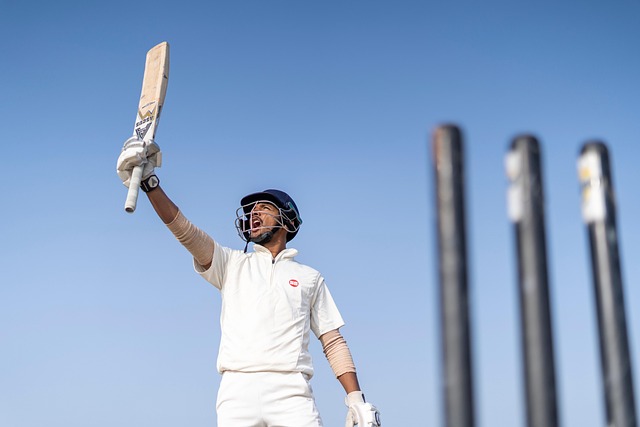
Cricket spin bowling (leg, off, googlies) is key for bowlers and batters, impacting match outcomes and strategy. Leg spin controls run rates, while top spin offers tactical swings and dips. Mastering these techniques, crucial for success, enhances on-field decisions, reduces injuries, and grows the positive cricket community. Spin bowling expertise is increasingly valued in fantasy games and cricket sponsorships.
In the intricate dance of cricket, spin is a game-changer. Understanding different types of spin allows bowlers to master various deliveries, bewilder batters, and seize control of the match. From leg spins that dip and turn to topspin’s deadly swing and dip, each has its unique application. This guide delves into the art of spin, offering insights on when to deploy leg spin, top spin, googlies, and off spin to dominate the cricket field.
- Understanding Spin Types in Cricket
- When to Use Leg Spin for Control
- Utilizing Top Spin for Swing and Dips
- Mastering Googlies and Off Spins
Understanding Spin Types in Cricket

In cricket, spin refers to the rotation of the ball, which significantly affects its movement and bounce. Understanding spin types is crucial for both bowlers and batters. There are three main types: leg-spin, off-spin, and googlies. Each has distinct characteristics that dictate their use in different playing conditions. Leg-spin, characterized by a clockwise rotation from the bowler’s perspective, offers significant turn and can be deadly on turning pitches or against batters out of form. Off-spin, rotating anti-clockwise, generally turns less but provides subtle variations, making it ideal for consistent performance across various surfaces. Googlies, a type of off-spin with an unusual bounce, are used to catch batters off guard with their unpredictable movement.
Cricket social media trends often highlight the art of spin bowling, with expert analyses and tips shared widely. Knowing when and how to employ these spin types can greatly impact match outcomes, as exemplified by successful bowlers who master various techniques. For those interested in cricket career paths, giving us a call at Cricket Career Paths can provide insights into honing these skills. Umpire’s decisions explained also touch on spin-related calls, emphasizing the importance of understanding ball movement for accurate on-field judgments.
When to Use Leg Spin for Control

In cricket, leg spin is a valuable asset for bowlers looking to gain control and deceive batters. This type of spin is particularly effective in various match formats explained cricket equipment guide situations, offering both variety and precision. The key to mastering leg spin lies in understanding when to deploy it.
Data-driven decision making suggests that leg spin should be used in specific scenarios, especially during the middle overs of a cricket technology innovations match. Its subtle turn and ability to grip the pitch make it ideal for slowing down the run rate without compromising on accuracy. Unlike other spin varieties, leg spin bowls closer to the batsman’s body, allowing bowlers to create angles and trap batters off guard. Visit us at cricket terminology dictionary anytime for a comprehensive overview of this art.
Utilizing Top Spin for Swing and Dips

In cricket, top spin is a powerful tool for achieving both swing and dip, offering bowlers a range of tactical options. When delivered with precision, it can cause the ball to swing laterally, moving inwards towards the batsman from the off-spin or outwards from the leg-spin. This movement, coupled with the dip (or decline) in trajectory, poses a significant challenge for batters, making it a go-to choice for many bowlers at all levels. The art of mastering top spin lies in understanding how to generate it efficiently through wrist and finger action, allowing for consistent and effective swing.
Beyond its impact on the pitch, the strategic use of top spin can also influence the umpire’s decisions regarding LBW (Leg Before Wicket) calls, as the ball’s trajectory and dip can make it harder for batters to avoid contact. This is one aspect where a deep understanding of spin techniques can benefit not just your cricket career paths but also enhance your ability to read the game and support mental health within the sport, as strategic awareness reduces pressure and increases focus. Remember, when you find us at cricket data visualization, exploring such nuances in the art of bowling can provide valuable insights into enhancing performance and contributing to a positive cricketing community while mitigating potential cricket injuries: causes and treatment.
Mastering Googlies and Off Spins

In cricket, mastering the art of spin bowling is a game-changer for any team. The ability to deliver both googlies and off spins can confuse batters and swing the momentum of a match in your favor. Googlies, characterized by their sharp turn and unpredictable nature, are particularly effective on sticky or uneven wickets. They’re a modern innovation in cricket history timeline, with early spin bowlers relying more on traditional off spins.
Off spins, while seemingly less dramatic, offer excellent control and consistency. Skilled bowlers can make the ball turn in multiple directions based on wicket conditions and batter preferences. To excel in these techniques, bowlers must focus on subtle variations in their grip, finger placement, and release. Fielding positions and roles become even more critical when spin bowlers are at work, as quick reactions and strategic placements can help restrict runs effectively. As cricket fantasy games gain popularity, understanding these spins becomes crucial for selecting the right bowlers to enhance team compositions. Even for fitness-focused cricketers, incorporating specific drills to improve spin bowling technique can significantly boost their overall performance on the field. Remember, give us a call at cricket sponsorship value proposition to learn more about how top brands are leveraging spin bowling prowess in today’s competitive cricket scene.
In the intricate game of cricket, mastering different spin types can significantly enhance a bowler’s performance. From leg spin’s subtle turn to top spin’s deadly swing, each technique serves a unique purpose. Googlies and off spins further add complexity, allowing bowlers to outsmart batters in various situations. By understanding when to deploy these spins, cricketers can manipulate the cricket ball with precision, becoming true masters of their craft on the field.






